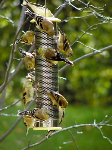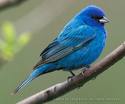-
sparrow’s at your finch bird feeder?
No, these aren’t Sparrows, but American Goldfinches in their drab winter plumage. A customer contacted me yesterday to see what could be done about the problematic House Sparrows in her yard. She said there were so many of them that the Goldfinches couldn’t even get near her finch bird feeder if they tried!
Although I’m not sure why, some folks admire and encourage House Sparrows… maybe it’s because that’s the only birds they can attract to their habitat? A non-native species (they should round them up and deport them back to Europe) along with Starlings, they wreak havoc on our native song birds. Bluebirds have no chance with sparrows around, and tree swallows too will lose out to sparrows for nesting cavities. Whole colonies of Purple Martins are chased away by sparrow invasion. I know there are no “mean birds” but sparrows instinct for survival is brutal with actual maiming and killing of nestlings and adults for use of the nest box.
So if you’re unlucky enough to have them in your yard… how do you get rid of them? First start by taking away the “welcome mat”. Try to remove the things that are attracting them, at least temporarily. Birdbaths should be emptied, and feeders taken down. I know this is a difficult task, but food in the wild is plentiful this fall (in most parts of the country) and it’s only for a short time, encouraging the sparrows to move on to other digs. Use quality birdseed too, it does make a difference. A mix that has a lot of corn or millet in it will also attract more “undesirable” birds.
Another option if you’re looking to attract Goldfinches only, is an upside down finch bird feeder. These are one of very few birds who will actually eat while perched upside down. And it’s not a bad thing… just being more selective about the beaked buddies you’re attracting to your yard!
-
new bird spotted at the finch bird feeder
Wow… if you think male bluebirds are vibrant blue – check out this little guy! An Indigo Bunting in brilliant cerulean blue was spotted a few days ago at my finch bird feeder. More common in Florida, it’s rare for them to make an appearance in my North Georgia yard. Once, and only once, a Painted Bunting also made a visit to the same finch feeder. Lucky are the folks who see these gorgeous birds on a daily basis!
And fast? They almost as quick as hummingbirds, it was difficult to get a good look at him. Possibly the leaf misters were attractive, or he’d seen all the other bird activity going on? For two or three days now, he’s been spotted at the same feeder.
More than just Goldfinches are attracted to a Finch Bird Feeder. This protective feeder sees many Chipping Sparrows in winter, as well as Chickadees, and House Finches. Just because a bird feeder may be labeled for a specific species, it will always attract more than just that bird. Finch mix is a great staple to offer feathered friends throughout the year.
-
why use an upside down finch bird feeder?
Too many finches in your yard… House Finches, Purple Finches stealing all the “black gold” known as nyjer (or thistle)? Here’s a tip you may not be aware of: Goldfinches are the only finch who will feed while perching upside down. Enter the upside down finch bird feeder! It discourages other finches while attracting American Goldfinches.
It’s exclusively for Goldfinches and really does the trick if your finch bird feeder is requiring too many trips to fill. One thing I’ve noticed in our yard is the finch feeders’ activity seems to cycle. Constantly gorging on thistle all winter, these feeders have less activity right now, while the finch bird feeders with mixed seed are jammed-packed mobbed.
Goldfinches have the latest nesting season of most song birds, so you can bet thistle feeders will once again be bustling from late June through the summer months. With dandelions out in full force, Goldfinches are also feasting on this favorite while the pollen flies and settles here in the southeast. If your finch bird feeder is seeing little or no activity now – be patient and don’t give up just yet. Warmer summer months will bring increased activity and vibrant yellow hues to yard! If the food sits too long though, it my spoil with heat and humidity, so just be sure thistle is fresh for all your new visitors.
Hanging some nesting materials in the yard will also encourage Goldfinches and others to take up residence at your place. Timing is key, so have materials out before the nesting season begins. Whether commercial nest materials, or easy home made ones, you’ll entice more feathered friends to stick around!




